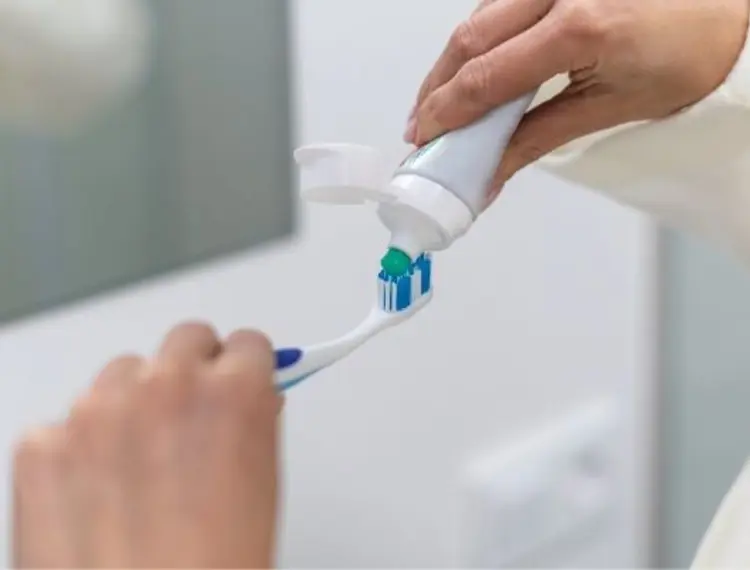
To get the best results when you brush your teeth, toothpastes contain ingredients called abrasives. These ingredients are added to help with cleaning the teeth and removing stains.
This article looks at how toothpaste abrasives help to remove dental plaque from the surfaces of the teeth. It also discusses the testing that is done to make sure that toothpastes work well and are safe.
Why are abrasives added to toothpaste?
A little bit of abrasive in your toothpaste can help the toothbrush bristles to grip the dental plaque and brush it away. Plaque is a sticky layer of bacteria that forms on the surface of the teeth. The plaque can build up both above and below the gums.
Abrasives also help to remove stains from the surface of the teeth. Without any abrasive, toothpastes would become a slippery gel. Therefore, adding an ingredient to toothpaste that make the pastes a little bit abrasive is a good thing. Reputable companies and manufacturers who make toothpaste add just enough abrasive to safely and gently clean teeth without damaging them.
How can we test that abrasives are safe?
Major toothpaste manufacturers measure and test the abrasive safety of toothpaste. This is done in a laboratory by measuring the radioactive dentine abrasivity index. This is also called the RDA. Toothpastes with an RDA of 250 or less are recommended as “safe for a lifetime of use”.
More information on the RDA
The RDA is an international standardised reference guide for toothpastes used in the lab by companies that make toothpaste. The RDA has been set as an international standard by the International Standards Organisation. International Standards are rules, guidelines and processes that are used to make sure that companies reach the same outcome. This helps to make sure that all over the world, toothpastes can be measured by the same guide for quality and safety. For a toothpaste to follow the standard, it must have an RDA of 250 or less. Toothpastes with an RDA of 250 or less are recommended as “safe for a lifetime of use”.
The RDA is supported by research. It is accepted by professional groups around the world. These groups include the British Standards Institute, the American Dental Association, and the World Dental Federation.
How does the RDA test compare to toothbrushing in real life?
Testing in the laboratory is different to brushing in a real mouth. There are extra layers of protection in the mouth that protect the teeth from abrasive toothpaste. These layers of protection are not included when testing in the laboratory.
The RDA test is done on dentine. But, in a real mouth we mainly brush tooth enamel. Dentine is located inside the layer of tooth enamel which is very hard and protects the dentine. Dentine can usually only be seen and brushed when the tooth enamel has been worn away. So, testing toothpaste on the softer dentine means there is less risk of the toothpaste damaging the teeth when brushing in a real mouth.
Saliva is very important for protecting the teeth and the mouth. It contains proteins that make a protective layer over the surface of teeth. This layer is called a pellicle. This protective layer is not included as part of the laboratory RDA testing. It provides another layer of safety when brushing in a real mouth.
The laboratory method to test the RDA uses between 1,500 and 3,000 brushstrokes all in the same place on the one tooth surface. This does not copy how the average person brushes their teeth or the different ways that people use their toothbrush when brushing.
This information shows that the conditions that are used in laboratory RDA testing are much more extreme than how the average person brushes their teeth every day. This is done to make sure that any toothpaste that meets the International Standards will be safe to use and still be good at cleaning the teeth.
Are there any differences between toothpastes that meet the standard?
The International Standards Organisation says that there are not different grades or levels in the standard. A toothpaste is not to be labelled as low, medium, or highly abrasive when it has an RDA of 250 or less. Think of it like a lift, or an elevator, which will have a safety limit recorded as a number of passengers or a total weight limit. It does not matter how many people are in the elevator if the total number of people is under the safety limit, but anything above the limit may cause damage.
Different RDA values under 250 do not mean that the toothpaste is more, or less, safe to use. But the RDA value can affect how well the toothpaste works to remove dental plaque when brushing. For example, a toothpaste with a very low RDA of about 50 is less likely to remove dental plaque well. In other words, toothpastes without abrasives may not clean teeth very well.
What factors can influence tooth wear?
The main factors that cause tooth wear are:
- Tooth erosion
- Grinding of teeth against one another
Tooth wear caused by forces on the teeth from outside the mouth is less common. This type of wear is called abrasion.
Factors that can increase the risk of tooth wear include:
- The way you brush your teeth. For example scrubbing the teeth very hard, brushing for a very long time, or brushing too soon after having acidic foods or drinks or vomiting.
- Having too many acidic food and drinks.
We need to think about all these factors when tooth wear develops.
Fluoride protecting the teeth from wear
Fluoride is a very important ingredient in toothpaste because it helps to protect teeth against tooth decay. There are three types of fluorides you may see listed on toothpaste tubes. These include sodium fluoride (NaF), stannous fluoride (SnF2), and sodium monofluorophosphate (SMFP).
As well as protecting teeth from decay, stannous fluoride can also help to protect teeth against tooth wear from erosion and tooth grinding. If a toothpaste with stannous fluoride and any RDA less than 250 is compared with a toothpaste with sodium fluoride and any RDA less than 250, the stannous fluoride will provide the teeth with extra protection against tooth wear using its barrier-forming properties.
Read more about the different ingredients added to toothpaste.
Summary
It is important to remember that toothpastes need to achieve a balance. We want to find a sweet spot where we have the right amount of abrasive that lets the toothpaste remove plaque and stains well, but still be safe for the enamel and dentine hard tooth structure.


